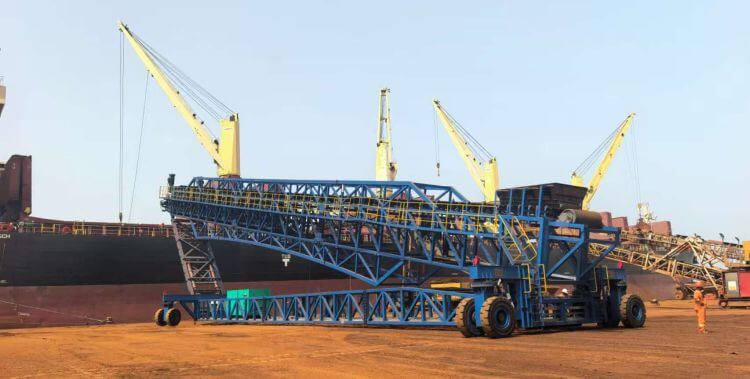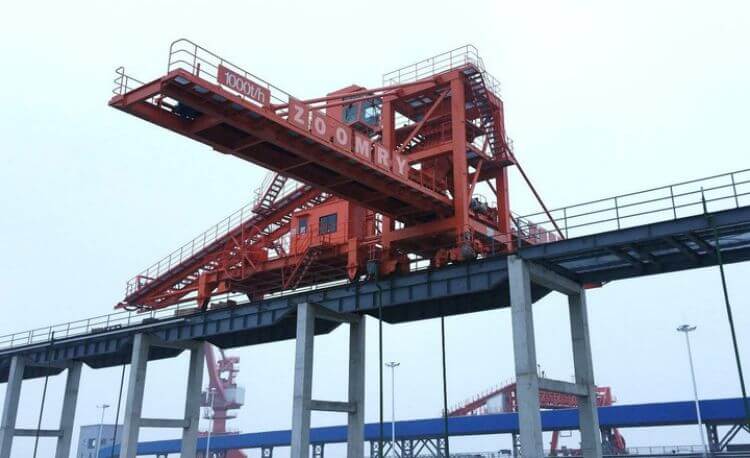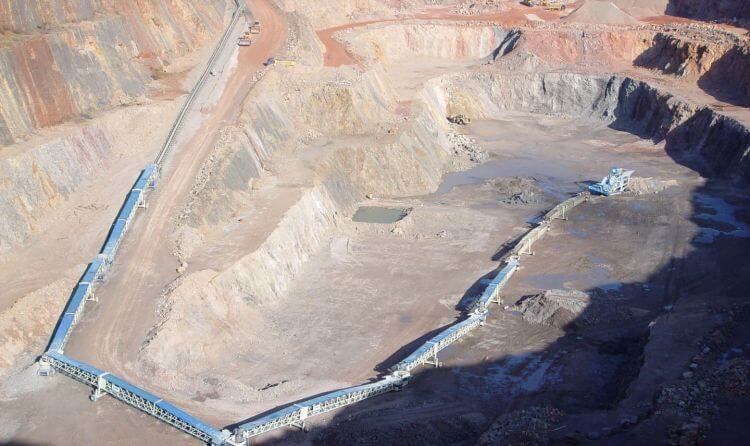When a bulk carrier loaded with iron ore docks at the terminal, and the silo 3 kilometers away from the shore is full of coal waiting to be loaded, while the port's temporary dispatch notices that the loading and unloading operations need to be completed within 24 hours — such emergency scenarios are not uncommon in ports around the world. For port operators, freight forwarders, or shippers, bulk material conveying is never a simple stack of equipment, but a systematic project that needs to be dynamically adjusted according to variables such as distance, time efficiency, and site conditions.

Three Core Conveying Needs and Pain Points Analysis in Bulk Ports
The conveying scenarios in bulk ports vary widely, but they can essentially be summarized into three core needs:
Unclear logic of conveying equipment — When shippers face port loading and unloading for the first time, they are often confused by terms such as "belt conveyor", "gantry crane", and "truck transfer". Due to their lack of understanding of equipment characteristics, such users tend to blindly choose transportation combinations, resulting in loading and unloading time far exceeding expectations, and may also incur additional costs due to site adaptation issues.
Upgrading needs of traditional solutions — Ports that have adopted fixed equipment often fall into the dilemma of "unable to modify, unable to replace". After years of use of fixed belt conveyor systems, if the ship type is upgraded, coverage blind spots may appear. Rebuilding fixed lines requires interrupting operations and incurs high costs. What's more tricky is the seasonal fluctuation of goods: existing equipment capacity is insufficient during the grain peak season, while there is idle waste during the off-season. This flexible demand is precisely the shortcoming of fixed equipment.
Solutions for complex scenarios — When faced with the triple constraints of "long distance + short time limit + no site", Traditional solutions are often at a loss. To load a large amount of bulk materials from a temporary silo several kilometers away from the terminal onto a ship in a short time, if the site is muddy and there is no hardened ground, fixed conveyors cannot be erected. Relying solely on truck transportation requires a large number of heavy trucks to work continuously, and may also cause congestion due to insufficient unloading positions at the terminal, which severely tests the mobility and system synergy of the equipment.

Comparison Between Fixed Conveying Equipment and Mobile Conveying Equipment
The original design intention of fixed conveying systems is to pursue large-scale efficiency, but their inherent defects have become increasingly prominent in the dynamic scenarios of global trade:
Lack of flexible scheduling — The track laying of fixed belt conveyors needs to match specific ship types and silo positions. Once the type of goods or ship specifications change, the entire system falls into the paradox of "functional surplus" or "insufficient capacity". However, the telescopic boom (maximum extension length up to 40 meters) and omnidirectional moving wheel set (steering angle ±90°) of Mobile Ship Loaders can complete the adaptation adjustment from handy ships to ultra-large bulk carriers within 30 minutes.
Shortcomings in emergency response — After extreme weather such as typhoons and heavy rains, fixed equipment often cannot resume work immediately due to track water accumulation and foundation settlement, while mobile equipment can be restarted with simple inspection, which can quickly regain the cargo transportation window.
Cost cumulative effect — The hidden costs of fixed equipment far exceed the initial investment: in terms of infrastructure, the cost of concrete foundations for each kilometer of fixed conveyors is relatively high; in terms of maintenance, annual expenditures such as roller replacement and belt repair account for 12%-15% of the original value of the equipment; in terms of environmental protection transformation, to meet environmental protection standards, the closed transformation of fixed systems requires additional investment. In contrast, the modular design of mobile equipment reduces infrastructure costs by 60%, the intelligent lubrication system (which can monitor bearing temperature in real time) extends the maintenance cycle from 3 months to 8 months, and the built-in negative pressure dust removal device (filtration accuracy up to 5μm) can meet the standards without additional transformation.
The core advantage of mobile conveying equipment lies in building a "dynamically adaptable" conveying network: when the distance between the silo and the terminal is long, grasshopper conveyors (maximum conveying distance 100 meters) can be used as "mobile bridges" for cascade overlapping, forming a flexible line with mobile ship loaders; when the site is narrow, telescopic stackers (minimum turning radius 6 meters) can complete steering in a 5-meter-wide channel; when switching cargo types, it only takes 5 minutes to replace the wear-resistant lining to switch from conveying coal to grain. This "plug-and-play" feature perfectly solves the rigidity problem of traditional solutions.
If you have any questions about high-quality material conveying solutions for ports, please contact us using the following information.
- Zoomry Heavy Industry Official Website
- +86 131-6401-6717
- oversea@zoomry.cn
High-Quality Material Conveying Solutions for Classic Scenarios
Emergency Loading of Long-Distance Materials at Ports
Scenario Requirements: The distance between the silo and the terminal is 3-8 kilometers, 10,000-30,000 tons of bulk materials need to be loaded onto the ship within 48 hours, and there is no hardened site for erecting fixed conveyors.
Pain Point Analysis: Truck transportation has three bottlenecks — limited single-load capacity (30 tons per truck), long waiting time for unloading at the terminal (average 20 minutes per truck), and 50% reduction in traffic efficiency when the road is muddy. Adopting a pure truck scheme requires a large number of vehicles to work continuously, and may also cause delays due to terminal congestion.
Zoomry Solution: Build a three-level conveying chain of "silo - grasshopper conveyor - mobile ship loader":
- First-level transfer: Deploy 1 fixed grasshopper conveyor at the silo outlet, which is rigidly connected to the silo discharge port through a rigid base, with a single-machine conveying capacity of 800 tons per hour. Its high-strength steel structure frame can withstand the instantaneous impact of materials falling from the silo (maximum impact load 120kN), ensuring the stability of the conveying starting point and avoiding material leakage caused by vibration.
- Second-level short-distance transportation: Configure 15 crawler-type grasshopper conveyors, forming a continuous conveying line in the mode of "head-to-tail overlapping + intelligent alignment". Each equipment has a crawler ground pressure of ≤60kPa, which can walk independently on muddy and soft ground; through the laser alignment system (accuracy ±3mm), rapid splicing is realized. 15 cascaded units can cover a conveying distance of 1.2 kilometers, and can automatically adjust the height according to the terrain undulation (vertical adjustment range ±2 meters) without prior site leveling.
- Third-level loading operation: Deploy 1 mobile ship loader at the terminal front, realizing seamless docking through the boom telescoping of the last crawler-type grasshopper conveyor. The ship loader is equipped with a rotatable discharge chute (360° rotation) and a telescopic boom (maximum extension 28 meters), which can adapt to different cargo holds of bulk carriers above 100,000 DWT. The conveying capacity can be precisely adjusted within the range of 500-3500 tons per hour through the frequency conversion system. Cooperating with the omnidirectional moving wheel set (traveling speed 2.5km/h), it can realize rapid switching of multiple cargo holds.
Solution Advantages:
- All-terRain Coverage: The off-road performance of crawler-type grasshopper conveyors can cope with complex sites such as mud, shoals, and gravel, saving site hardening costs (saving about 1.5 million yuan in infrastructure costs per kilometer).
- Efficient continuous operation: The entire system realizes uninterrupted conveying from the silo to the cargo hold, with a total efficiency of 3500 tons per hour. Loading 30,000 tons of goods onto the ship only takes 10 hours.
- Flexible elastic configuration: The number of crawler-type grasshopper conveyors can be increased or decreased according to the actual distance (3-15 units adjustable), avoiding equipment idleness and reducing unit conveying costs.
- Environmental protection compliance: The whole system is equipped with a closed conveying channel and a negative pressure dust removal device (dust emission concentration ≤10mg/m³), which meets the EU CE and US EPA environmental protection standards.

Multi-Variety Mixed Loading Scheme
Scenario Requirements: The same terminal needs to complete the loading operations of three bulk materials (coal, grain, and mineral sand) within 24 hours, with each material quantity of about 5000 tons, and the ship is a multi-hold bulk carrier.
Pain Point Analysis: When fixed equipment switches varieties, it is necessary to thoroughly clean the residual materials (about 2-3 hours per time), and different materials have different degrees of wear on the equipment (mineral sand wears the belt 5 times more than grain). Frequent switching will reduce the equipment life by 30%.
Zoomry Solution: Adopt the strategy of "one machine for multiple uses + rapid model change":
- Equipment selection: The main equipment is 1 multi-functional mobile ship loader (ZRSL series), equipped with replaceable wear-resistant components — install ordinary rubber belts when conveying coal, replace with ceramic wear-resistant belts (service life extended by 4 times) when conveying mineral sand, and add food-grade stainless steel linings (meeting FDA standards) when conveying grain.
- Cleaning system: Integrate a two-stage cleaning device. The first stage uses a rotating brush to remove surface residues, and the second stage uses high-pressure air flow (0.6MPa) to purge gaps, shortening the cleaning time to 30 minutes per time.
- Intelligent scheduling: Preset the conveying parameters (speed, inclination angle, dust removal intensity) of the three materials through the PLC control system. When switching, only the corresponding program needs to be called, and the parameter reset can be completed within 5 minutes.
Solution Advantages:
- Switching efficiency: The total switching time for loading three materials is controlled within 2 hours, saving 6 hours compared with traditional schemes.
- Equipment protection: Targeted wear-resistant design reduces equipment failure rate by 50% and annual maintenance cost by 250,000 US dollars.
- Cross-contamination control: The cleaning system can control the residual amount below 0.1%, meeting the hygiene requirements for grain transportation.
Stacking Solution for Narrow Sites
Scenario Definition: The width of the terminal yard is only 20 meters, 8000 tons of limestone need to be stacked, and it needs to be transferred to another berth for loading after 3 days. The stacking height is required to be no less than 6 meters to save space.
Pain Point Analysis: The minimum operating radius of traditional fixed stackers is 15 meters, which cannot achieve 360° rotation in a 20-meter-wide site, and the stacking height is limited (≤4 meters), resulting in the need to rent additional temporary yards and increase transfer costs.
Zoomry Solution: Deploy 1 telescopic stacker:
- Space adaptation: The equipment adopts a folding boom (retracted length 12 meters, maximum extended length 20 meters), with a minimum turning radius of 5 meters, which can complete 90° steering in a 20-meter-wide site, realizing "wall-side stacking".
- Stack shape control: Equipped with a laser level sensor, it automatically adjusts the boom height (adjustable from 3-8 meters). The stacking cross-section is trapezoidal (8 meters wide at the bottom, 4 meters wide at the top), ensuring stable stacking and maximum space utilization.
- Rapid transfer: After 3 days, directly start the equipment to move to another berth (traveling speed 3km/h), and dock with the mobile ship loader through boom telescoping, eliminating the secondary transfer link.
Solution Advantages:
- Space utilization: The stacking height is increased by 50%, and 8000 tons of limestone can be accommodated without additional yards.
- Transfer efficiency: Directly moving the equipment to complete the transfer saves the loader transfer link, reducing the time from 12 hours to 3 hours.
IV. Choose Zoomry Heavy Industry
- Preliminary survey: Send engineers to collect on-site data (terrain, meteorology, cargo characteristics, etc.), use BIM technology to simulate the equipment operation process, and avoid site conflicts in advance.
- Customized design: Provide low-temperature version equipment for high-latitude ports (normal start-up at -30℃), and add anti-corrosion coatings for tropical ports (salt spray resistance grade 1000 hours).
- Rapid response: There are spare parts centers in Germany, Brazil, and the United Arab Emirates. Regular parts can be delivered within 48 hours; 80% of equipment failures can be solved through the remote diagnosis system (response time ≤30 minutes).
- Training and certification: Provide operator training (theory + practice), and issue internationally recognized operation certificates after passing the assessment to ensure that the local team can work independently.

 ZOOMRY
ZOOMRY

